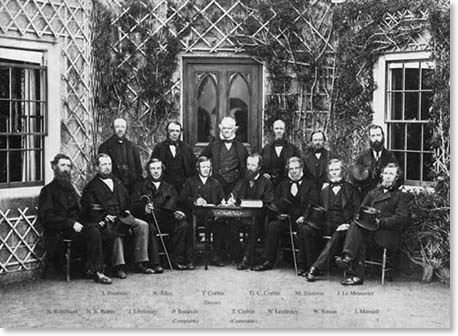
St Pierre du Bois Douzaine
- 1870
The twelve Douzeniers (the Douzaine) and
the two Constables who assembled in front of St. Pierre du
Bois Rectory for this photograph in 1870 would have been
confident of their status and influence. They were elected
by and from amongst the 'chefs de famille', that is the
heads of households who owned the larger farms in the
parish and who were liable to pay parish rates. Through
their representatives, the 'voice of the people' in the
States of Deliberation, they were involved in the major
political and fiscal reforms of the 19th century.
However the story of the next hundred and forty years would
be one of the Douzaines, and the Parish Assemblies that
they served, steadily losing control and responsibility,
sometimes voluntarily but more often reluctantly, to a
States of Deliberation which was evolving into a modern
democratic institution.
Until the 19th Century a
Douzaine’s functions had been customary. In the course of
that century most of these customary functions, together
with the taxation and penalty systems to fund them, were
enshrined in statutory law.
A Douzaine's primary functions at the time of the
photograph were;
i) to
assess and record the ownership, extent and rental value of
land for parochial and States taxation and for inheritance
purposes.
ii) to advise the Parish Assemblies on the sums to
be raised through the rates to support primary schooling, a
police force (if any), the hospitals and the poor.
iii) to oversee the ancient public highways,
including any new work within ten feet of the roadway, and
to ensure that the roads and their boundaries were
maintained by landowners.
iv) to nominate jurats and to vote at the States of
Election.
v) to elect and brief their representative before
assemblies of the States of Deliberation.
vi) to elect Douzeniers to sit on
States' Committees.
Today all that remain of the primary functions listed above
are those in connection with the States of Election and the
control of the boundaries to public highways eg issuing
notices regarding dangerous structures, granting
bornements, etc. Some new functions were added in the 20th
century but with the growth of the services provided by the
States through taxation, in particular education and
healthcare, the relative importance of the Douzaines
declined.